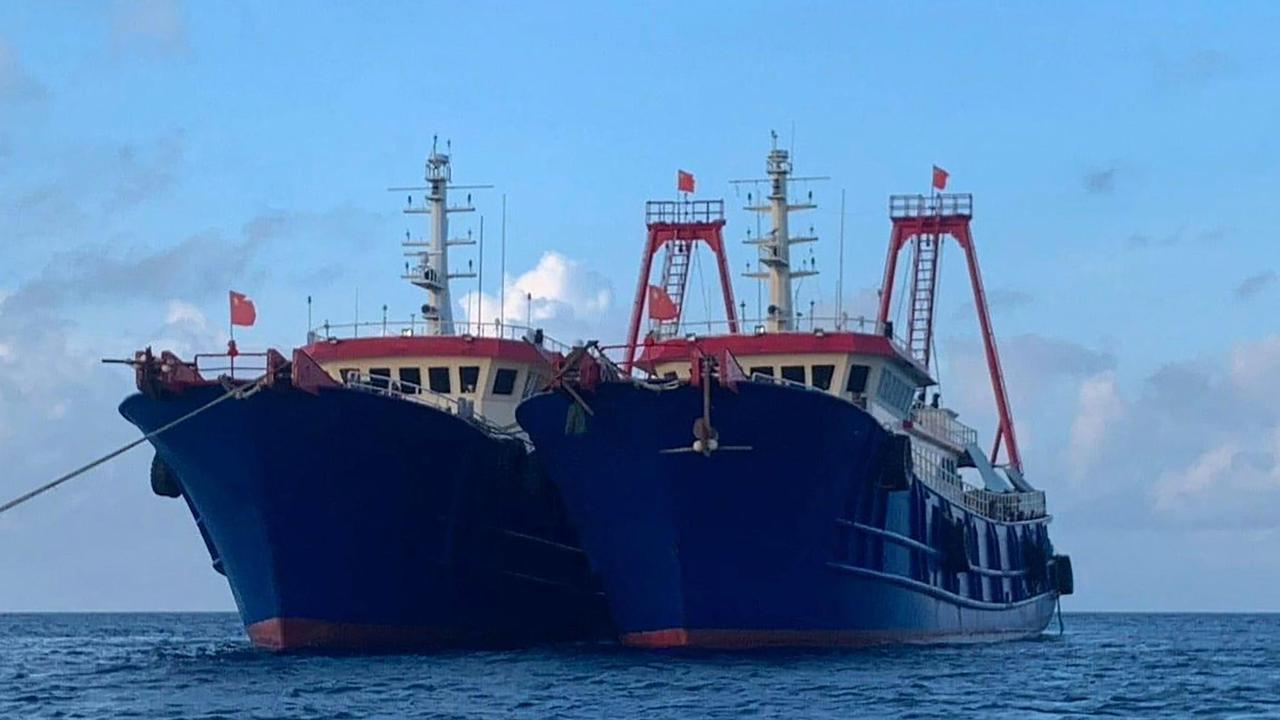GPS plots reveal secret game of ‘chicken’ in South China Sea
As tensions reach boiling point, satellite images have revealed a secret, month-long game of chicken that played out in the South China Sea.

A high-stakes, month-long game of chicken has been played out in the contested South China Sea.
One participant a Vietnamese fishing boat. The other was an armed Chinese Coast Guard cutter.
Such harassment on the high seas is not an unusual event.
Last April, a Vietnamese fishing boat was rammed and sunk by China’s Coast Guard. Beijing insists the small timber vessel was the one that charged its dramatically larger, armed and armoured cutter.
What is unusual is the way this incident was revealed.
And it happened after a January decision by Beijing to allow its Coast Guard to “open fire” on what it arbitrarily deems to be intruders.
The US government-funded Radio Free Asia collated satellite and automatic identification (AIS) tracking data to observe coast guard cutters stalking the fishing boat between February 22 and March 16.
The incident took place south of the Paracel Islands, a cluster of reefs and rocks that the two nations fought a brief war over in 1974.
China now occupies the disputed archipelago. Beijing recently constructed one of its controversial island fortresses there on Woody Island.

Game of chicken
The RFA investigation first tracked the CCG 4203 approaching the Vietnamese Benhai 08629 on February 22. At this point, it was some 45km southwest of the Paracel’s Triton Island and 220km off the coast of Vietnam.
The two vessels engaged in a constant game of “duck and weave” as the Chinese cutter attempted to use the international right of way rules – and its intimidating bulk – to force it out of the area.
The Zhaojun-class cutter is armed with a 76mm cannon, machine guns and light arms. It is 102m long and weighs 2700 tons.
Its civilian opponent was about half that size.
RELATED: Australia ‘defenceless’ against China’s new bomber
After three days of constant harassment, the CCG 4203 retired to refuel and reprovision.
But on March 7, it returned. It again had Benhai 08629 in its sights.
The Vietnamese vessel eventually capitulated and returned to port on March 16.
But a Vietnam Fisheries Resources Surveillance ship, the Kiem Ngu 372, escalated matters by patrolling the same area the deadly dance had unfolded.
It found itself quickly shadowed by a Chinese Maritime Militia vessel – a fishing trawler commanded by Chinese Communist Party commissars and paramilitary crews that rarely, if ever, do any fishing.

‘Leave immediately’
The incident came as Chinese Maritime Militia trawlers began to “swarm” Union Banks, part of the Spratly Island group off the Philippines’ coast.
Up to 220 fishing vessels were observed tied together in neat rows within Whitsun Reef’s shelter on March 7. At last count, on March 27, the number was 199 vessels. Many now occupy nearby reefs.
Under clear blue skies and on calm seas, Beijing declared the militia to be “sheltering” from bad weather. It later amended this message to one of, ‘it’s our territory anyway, we’ll do what we want there’.
Manila has since protested the breach of its exclusive economic zone and sent military aircraft to overfly the fleet.
One plane was met with a warning, “You are approaching a Chinese reef. To avoid any move that may cause misunderstanding, please leave immediately.”
The National Task Force for the West Philippine Sea continued to assert Philippine sovereignty in the West Philippine Sea as Chinese Maritime Militia (CMMs) vessels, estimated to be 60-100 meters in length, were spotted swarming around the Julian Felipe Reef on March 27, 2021. pic.twitter.com/QHIqDCrbt4
— PCOO Global Media Affairs (@pcooglobalmedia) March 31, 2021
RELATED: China accused of gaslighting over maritime militia
The aircraft refused to cede ground, replying, “This is Philippine government aircraft. We are conducting routine maritime patrol over Philippine EEZ, and we are proceeding based on our planned route.”
A separate March 30 overflight appeared to confirm Manila’s worst fears – that Beijing was preparing to turn Union Banks into another of its artificial island fortresses.
Manila also claims “illegal structures” can be seen on the cluster of sandbars and reefs.
“These constructions and other activities, economic or otherwise, are prejudicial to the peace, good order, and security of our territorial waters,” the Armed Forces of the Philippines (AFP) said in a statement.

Escalation threat
Vietnam and the Philippines aren’t the only target of China’s increased hip-and-shoulder presence tactics.
Beijing also has accused Japan of “negative moves” in the East China Sea as its own ships move in on contested territory.
“China’s Defence Department stressed the fact that the (Senkaku) Islands and its affiliated islets are all China’s inherent territory,” Defence Ministry spokesman Wu Qian declared earlier this week.
Japan – and Taiwan – disagree.
“Japan should stop all provocative moves involving the (Senkaku) problem,” Mr Wu added, saying Tokyo must “stop smearing China and take practical actions to maintain China-Japan relations”.
RELATED: US Coast Guard sent to South China Sea to ‘free up shooters’
The tough talk comes after China’s Coast Guard began making fresh incursions into disputed waters.
Relations between the two nations soured further after China passed new laws in January enabling its Coast Guard to open fire on foreign ships.
It’s an escalatory act that may soon provoke further escalation.
Washington has ordered its own Coast Guard to begin operating in the Western Pacific in an effort to uphold the rule of international law. It’s signed an agreement with Taiwan seeking partnerships for logistics support, improved communications and information sharing.
“It’s possible for Japan to join the US in signing another MOU with Taiwan, a provocative move in the eyes of the PLA challenging Beijing’s red line on the Taiwan issue,” Hong Kong-based military analyst Song Zhongping told the South China Morning Post.

Letter of the law
“China’s new law contains unusually explicit language in Article 22 regarding the application of force in situations related to sovereignty and maritime rights,” an Asia Maritime Transparency Initiative (AMTI) analysis reads.
Article 22 states, “When national sovereignty, sovereign rights, or jurisdiction is being illegally violated at sea by a foreign organisation or individual, or is in imminent danger of illegal violation, a coast guard agency shall have the power to take all necessary measures including the use of weapons to stop the violation and eliminate the danger according to this Law and other applicable laws and regulations.”
RELATED: Tensions at ‘maximum’ as Beijing warns of confrontation
AMTI notes that “at first glance this would appear to give CCG vessels wide latitude to use weapons against, for example, a foreign vessel fishing in China’s claimed exclusive economic zone”.
“The law gives the power to ‘take all necessary measures including the use of weapons’ to stop not just an ongoing violation, but even an ‘imminent danger’ of violation,” AMTI says.
But, one piece of context muddies the intention of the order and gives Beijing a degree of deniability – such measures must be undertaken “according to this Law and other applicable laws and regulations”.
“The new Chinese law leaves room for interpretation,” AMTI concludes.
Jamie Seidel is a freelance writer | @JamieSeidel




